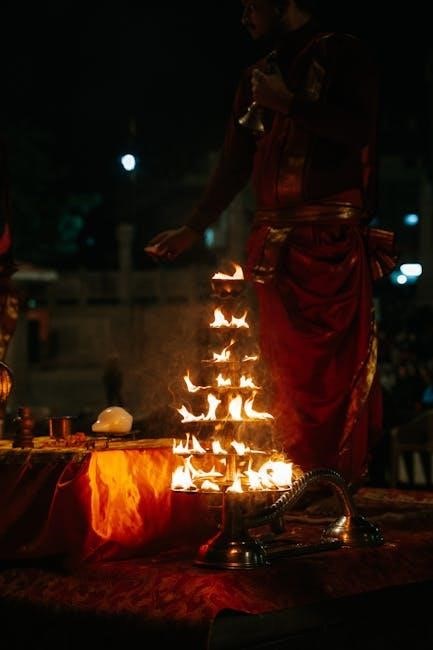Soundarya Lahari is a revered hymn by Adi Shankaracharya, extolling the Divine Mother’s beauty in Sanskrit. Available as PDF, it includes lyrics, translations, and commentaries, enriching cultural and spiritual practices.
1.1 Historical Significance of Soundarya Lahari
Soundarya Lahari, composed by Adi Shankaracharya, is an ancient hymn glorifying the Divine Mother. Its historical significance lies in its roots in 8th-century CE, blending spirituality and philosophy. The text, divided into 100 verses, is a cornerstone of Devi worship, reflecting deep reverence for feminine divinity. Its verses, available in Sanskrit PDF, have influenced rituals, art, and culture, making it a timeless spiritual and literary treasure, celebrated in Navaratri and beyond, ensuring its enduring relevance in modern times.
1.2 Overview of the Text
Soundarya Lahari is a poetic hymn comprising 100 verses, celebrating the beauty and divine power of the Goddess. Composed by Adi Shankaracharya, it blends philosophical insights with lyrical descriptions. The text is divided into two parts: the first 41 verses describe the Goddess’s divine beauty metaphorically, while the remaining 59 verses are mantras for worship. Available in Sanskrit PDF, it includes transliterations, translations, and commentaries, making it accessible for spiritual practices and scholarly study. Its verses are often chanted in rituals and ceremonies, enhancing their spiritual significance.
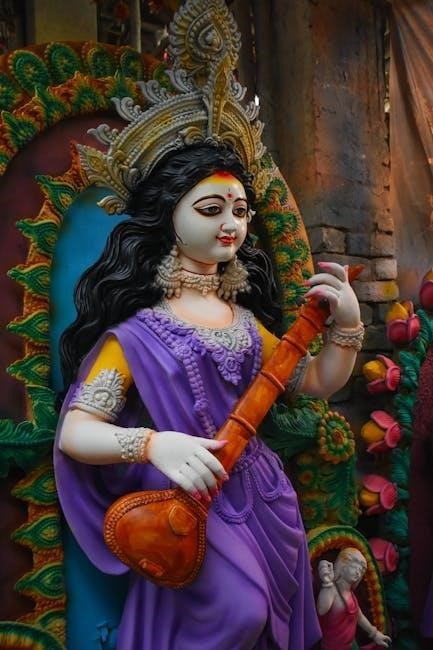
Structure of Soundarya Lahari
Soundarya Lahari consists of 100 verses, divided into two parts: the first 41 verses describing the Goddess’s divine beauty and the remaining 59 as worship mantras, blending philosophy and poetic beauty.
2.1 Number of Verses and Their Composition
Soundarya Lahari comprises 100 verses, meticulously composed in Sanskrit. The text is divided into two distinct sections: the first 41 verses extol the divine beauty of the Goddess, while the remaining 59 verses are structured as powerful mantras for worship. Each verse is crafted with poetic precision, blending philosophical depth with artistic expression. The composition reflects a seamless fusion of devotion, philosophy, and artistry, making it a revered text in both spiritual and literary realms.
2.2 Language and Style of the Text
Soundarya Lahari is composed in classical Sanskrit, with a poetic and philosophical style. The text employs various meters, including Anushtubh and others, creating a rhythmic and melodic flow. Rich in imagery, it uses metaphors and similes to describe the divine beauty of the Goddess. The language is both devotionally charged and aesthetically pleasing, blending spiritual profundity with literary elegance; This unique style makes it a masterpiece of Sanskrit literature and a profound spiritual guide.
2.3 Blend of Philosophy and Poetry
Soundarya Lahari masterfully integrates profound philosophy with exquisite poetry. It explores non-dualistic Vedanta through vivid imagery, symbolizing the divine feminine. The text weaves spiritual concepts with artistic expression, making complex ideas accessible through poetic beauty. Its verses evoke devotion while imparting philosophical truths, creating a unique harmony between intellect and emotion. This blend enhances its spiritual depth, appealing to both scholars and devotees, ensuring its timeless relevance and universal appeal.

Authorship and Attributions
Soundarya Lahari is traditionally attributed to Adi Shankaracharya, but scholarly debates question its authorship, suggesting it may be a later composition inspired by his philosophical legacy.
3.1 Adi Shankaracharya’s Role in Soundarya Lahari
Adi Shankaracharya is traditionally credited with composing Soundarya Lahari, a text embodying his reverence for the divine feminine. His authorship is often linked to his philosophical framework of Advaita Vedanta, blending devotion and metaphysics. While debates persist about the text’s historical origins, Shankaracharya’s influence is undeniable, as it reflects his profound spiritual insights and poetic brilliance, making it a cornerstone of Shakti worship and spiritual practices in Indian tradition.
3.2 Debates on Authorship and Historical Context
Despite traditional attribution to Adi Shankaracharya, debates persist over Soundarya Lahari’s authorship. Some scholars question if Shankaracharya, an 8th-century philosopher, could have written such a text, suggesting it may postdate him. Historical context remains unclear, with theories linking it to later Advaita Vedanta traditions. While its roots in Shakta philosophy are evident, definitive proof of authorship and exact historical origins remain elusive, leaving room for ongoing academic discussion and speculation.

Cultural and Spiritual Significance
Soundarya Lahari holds profound cultural and spiritual importance, revered for its poetic glorification of the divine feminine. It is widely used in rituals, embodying deep philosophical truths and spiritual elevation.
4.1 Role in Devi Worship and Feminine Divinity
Soundarya Lahari is a cornerstone of Devi worship, celebrating the divine feminine as the ultimate reality. It extols the cosmic energy of the goddess, symbolizing creation, preservation, and destruction. The text is deeply embedded in rituals, invoking her grace for spiritual and material prosperity. Its verses, rich with poetic imagery, glorify the goddess’s nurturing and powerful aspects, making it a revered hymn in feminine divinity worship, both in temples and personal devotion. Its availability in Sanskrit PDFs has enhanced its accessibility for modern practitioners.
4.2 Use in Spiritual Practices and Rituals
Soundarya Lahari is integral to spiritual practices, particularly in mantra recitation and meditation. Its verses are chanted during rituals to invoke divine grace and seek spiritual enlightenment. The text is often used in Navaratri celebrations, emphasizing the worship of the feminine divine. Availability in Sanskrit PDF has made it accessible for daily recitation, aiding devotees in integrating its teachings into yoga and meditation. This sacred text bridges the gap between spiritual practices and material well-being, fostering a balanced life.
4.3 Impact on Indian Art and Culture
Soundarya Lahari has profoundly influenced Indian art and culture, inspiring numerous classical dance performances and musical compositions. Its verses are often depicted in temple sculptures, symbolizing divine beauty. The text’s imagery enriches literature and poetry, while its themes are central to classical dance dramas. Availability in Sanskrit PDF has further facilitated its adaptation into various art forms, ensuring its timeless appeal. This integration of spirituality and art continues to inspire modern Indian culture and creativity.
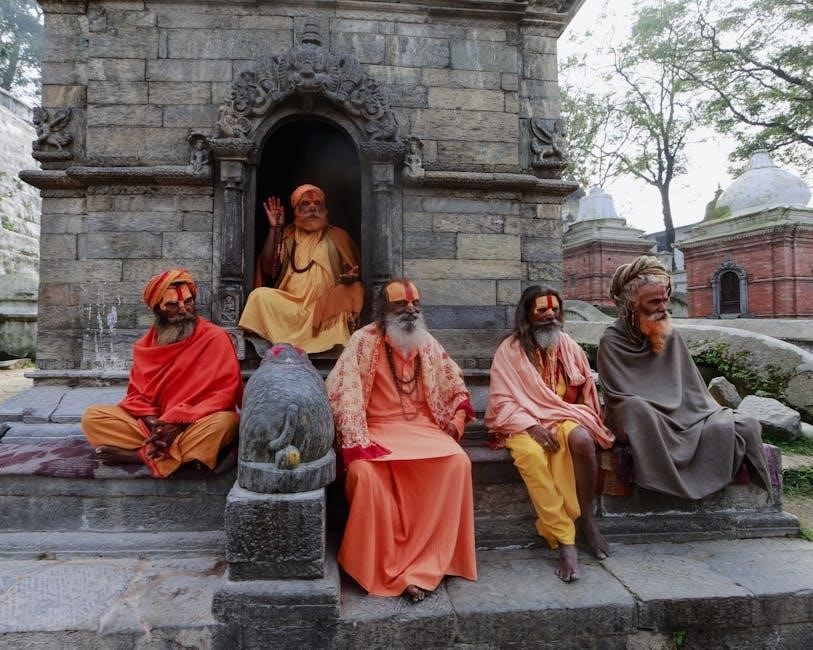
Availability of Soundarya Lahari in Sanskrit PDF
Soundarya Lahari is widely available in Sanskrit PDF format from various sources, including official Hindu temple websites and digital archives, making it accessible for spiritual and academic purposes.
5.1 Sources for Downloading the PDF
Soundarya Lahari in Sanskrit PDF is available for download from numerous sources, including official temple websites, digital archives, and spiritual organizations. Prominent temples like Sringeri Sharada Peetham and other religious institutions provide authentic versions. Additionally, platforms such as Google Drive, Dropbox, and online forums often host downloadable links. These sources ensure accessibility, catering to both spiritual practitioners and scholars seeking the text in its original form.
5.2 Features of the Sanskrit PDF Version
The Sanskrit PDF version of Soundarya Lahari offers clear typography, preserving the original script’s beauty. It includes accurate diacritics and traditional formatting, ensuring authenticity. Many versions feature transliteration guides for easier recitation. Some PDFs also include commentaries or explanations, enhancing understanding. The text is often presented in a readable font size, making it suitable for both digital and print use. Compatibility across devices ensures seamless access for spiritual practitioners and scholars alike.
5.3 Transliteration and Commentary Resources
Transliteration resources for Soundarya Lahari in Sanskrit PDFs provide Roman script equivalents, aiding non-Sanskrit speakers in pronunciation. Commentary resources, often included alongside the text, offer insights into philosophical and spiritual meanings. Scholars and spiritual leaders contribute these explanations, making the verses more accessible. These resources are invaluable for deeper understanding and are frequently bundled with the PDF versions for comprehensive study and recitation purposes.
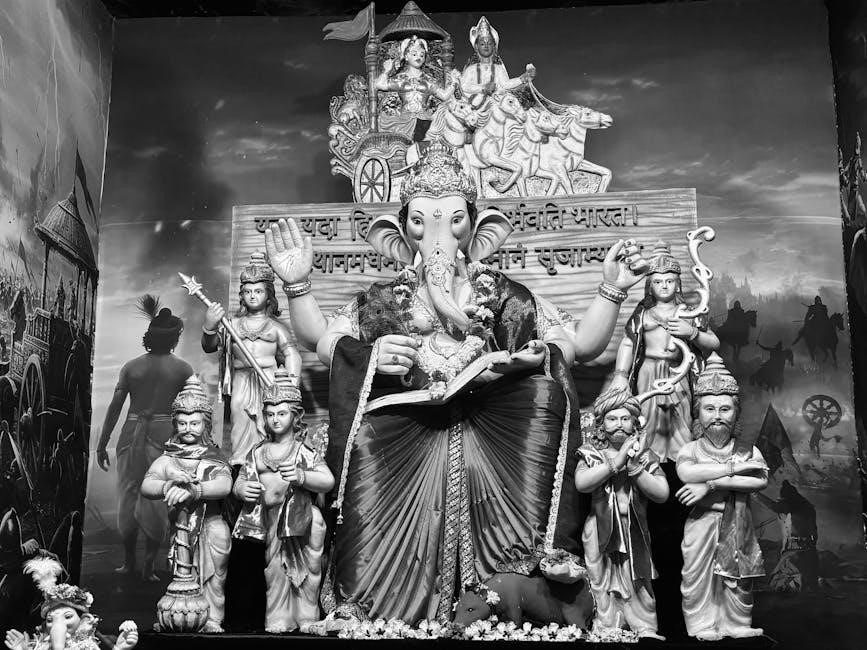
Translations and Interpretations
Soundarya Lahari is translated into multiple languages, offering diverse interpretations. English, Tamil, and other regional translations make the text accessible globally, preserving its spiritual essence.
6.1 English and Regional Language Translations
The Soundarya Lahari is available in English and various regional languages, facilitating its reach to diverse audiences. Translations by scholars and spiritual leaders have preserved its essence, making it accessible to those unfamiliar with Sanskrit. These translations often include commentary, enhancing understanding of the philosophical and poetic depth. Regional translations, such as Tamil and Telugu versions, further emphasize its cultural and spiritual significance, ensuring its timeless message resonates across linguistic barriers and generations.
6.2 Commentary by Scholars and Spiritual Leaders
Renowned scholars and spiritual leaders have provided insightful commentaries on Soundarya Lahari, unpacking its philosophical depth and poetic beauty. These commentaries bridge ancient wisdom with modern understanding, making the text accessible to contemporary readers. Eminent figures like Adi Shankaracharya and modern gurus have contributed interpretations, highlighting its spiritual and devotional significance. Their works often integrate historical context, theological insights, and practical applications, enriching the reader’s understanding of this revered text.
6.3 Comparative Analysis of Different Versions
Different versions of Soundarya Lahari in Sanskrit PDF vary in authenticity, commentary, and script style. Some versions include transliterations and translations, while others focus solely on the original Sanskrit text. Comparative analysis reveals variations in interpretations and annotations, reflecting diverse scholarly perspectives. Regional editions may incorporate local linguistic nuances, enriching the text’s universal appeal. These differences highlight the text’s adaptability while preserving its core spiritual essence, catering to both scholars and devotees seeking deeper understanding;
Musical and Artistic Renditions
Soundarya Lahari’s verses have been transformed into soulful music, chants, and classical dance performances, blending spirituality with artistic expression. Its rhythmic beauty inspires creative interpretations.
7.1 Soundarya Lahari in Music and Chanting
Soundarya Lahari’s verses are often rendered in melodious chants and classical music, enhancing their spiritual essence. Traditional Vedic chanting preserves the text’s rhythmic beauty, while classical compositions like ragas add emotional depth. Devotees and musicians worldwide adapt these hymns into soulful renditions, blending tradition with creativity. The Sanskrit PDF versions include notations, guiding singers and instrumentalists. This fusion of sound and spirituality makes Soundarya Lahari a timeless celebration of divine praise and artistic expression.
7.2 Hema Malini’s Contribution to Soundarya Lahari
Hema Malini, a renowned Indian actress and dancer, has contributed significantly to popularizing Soundarya Lahari through her artistic interpretations. She produced a Sanskrit film, Soundarya Lahari, blending devotion with visual artistry. This work showcases the text’s spiritual depth and aesthetic appeal, making it accessible to a broader audience. Her efforts have inspired many to explore the text’s philosophical and cultural richness, bridging tradition with modern media.
7.3 Use in Classical Dance and Theater
Soundarya Lahari is widely used in classical dance and theater to depict divine femininity and spiritual bliss. Dancers often perform to verses from the text, interpreting its poetic imagery through intricate movements. Themes of devotion, cosmic energy, and the divine feminine resonate deeply in Bharatanatyam and Odissi performances. Notable artists have choreographed entire productions based on Soundarya Lahari, blending its philosophical depth with artistic expression, making it a cornerstone of spiritual and cultural performances in India and globally.

Connection to Other Scriptures
Soundarya Lahari resonates with themes in Durga Saptashati, Lalita Sahasranama, and Vedic texts, emphasizing divine feminine power and cosmic order, aligning with broader Hindu scriptural traditions and rituals.
8.1 Relation to Durga Saptashati
Soundarya Lahari shares thematic parallels with Durga Saptashati, both venerating the divine feminine. While Durga Saptashati narrates the goddess’s valiant deeds, Soundarya Lahari poeticizes her beauty and cosmic essence, reflecting complementary aspects of Devi. Both texts are integral to Devi worship, blending philosophical depth with spiritual devotion, and are often studied together in Sanskrit for ritual and meditative practices, enhancing their cultural and religious significance in Hindu tradition.
8.2 Links to Tantric and Puranic Texts
Soundarya Lahari resonates with themes from Tantric and Puranic traditions, emphasizing the divine feminine’s power. Its verses reflect Tantric principles like mantra and yantra, while paralleling Puranic narratives of Devi’s cosmic roles. This text bridges ritualistic and philosophical aspects, offering a devotional synthesis. In the Sanskrit PDF, scholars can trace its alignment with broader Hindu scriptures, highlighting its spiritual depth and cultural relevance, making it a vital resource for understanding India’s rich religious tapestry.
8.3 Mention in Dasha Mahavidyas
Soundarya Lahari is deeply connected to the Dasha Mahavidyas, embodying the divine feminine’s ten wisdom forms. The text glorifies Tripura Sundari, a central Mahavidya, reflecting her cosmic and nurturing essence. Its verses resonate with the Trika system, linking it to Kashmir Shaivism. The Sanskrit PDF highlights these connections, offering insights into the goddess’s universal role. This text is a spiritual bridge, illustrating the unity of feminine power across Hindu traditions, making it a revered resource for those exploring Dasha Mahavidyas and their profound symbolism.
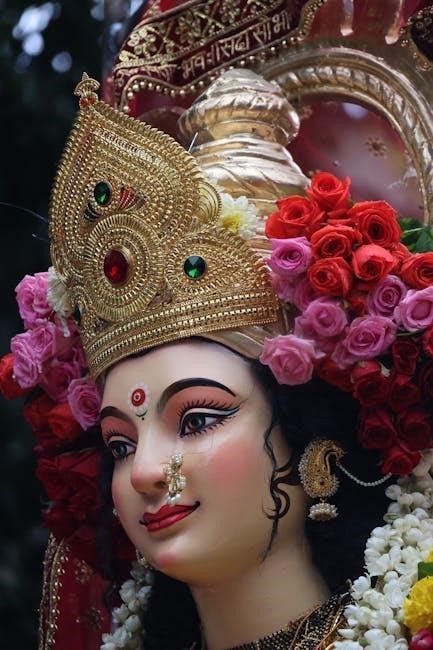
Authenticity and Preservation
Soundarya Lahari’s authenticity is preserved through ancient manuscripts and digital efforts, ensuring its Sanskrit PDF remains true to the original, despite challenges in modern transcription accuracy.
9.1 Historical Manuscripts and Sources
Soundarya Lahari’s historical manuscripts, preserved on palm-leaf and birch bark, are rare and invaluable. These ancient sources, often stored in temple libraries and private collections, provide original insights into the text. Adi Shankaracharya’s authorship is supported by these manuscripts, which are meticulously transcribed in Sanskrit. Scholars rely on these sources to validate the text’s authenticity, ensuring its spiritual and philosophical integrity remains intact for future generations.
9.2 Efforts in Digitization and Modern Access
Efforts to digitize Soundarya Lahari have made it accessible to a global audience. Organizations like GRETIL and archive.org host digital versions, preserving the text for future generations. Modern platforms offer downloadable PDFs, often with transliterations and commentaries. These initiatives ensure that the sacred text remains accessible, fostering its study and spiritual practice in the digital age while maintaining its original essence and cultural significance.
9.3 Challenges in Maintaining Authenticity
Maintaining the authenticity of Soundarya Lahari in Sanskrit PDFs is challenging due to potential misinterpretations in translations and digital errors. The complexity of Sanskrit nuances increases the risk of inaccuracies. Multiple digital versions may lead to confusion about the most reliable text. Additionally, while scholarly commentaries enhance understanding, they can introduce personal biases. Ensuring accurate digital encoding to reflect the original script correctly is also crucial. These factors highlight the need for meticulous preservation to uphold the text’s integrity and original intent.

Practical Uses of Soundarya Lahari
Soundarya Lahari is a sacred Sanskrit text revered for its devotional significance, attributed to Adi Shankaracharya, and is a hymn to the Divine Mother, extolling her beauty and power. It holds a prominent place in Hindu traditions, particularly in the worship of the feminine divine. Beyond mere reading, it is utilized in various practical spiritual and ritualistic contexts.
In meditation, verses from Soundarya Lahari are often chanted to focus the mind and connect with the divine feminine energy, aiding in creating a meditative state. The text is also incorporated into daily rituals and pujas, where specific verses may be recited to invoke blessings and maintain spiritual discipline.
During festivals like Navaratri, a nine-day celebration honoring the divine mother, Soundarya Lahari is recited to enhance devotion and spiritual ambiance. In yoga practices, chanting or recitation of its verses can prepare the mind and body for meditation or asanas, helping practitioners align with spiritual energies.
While the text is available in digital PDF formats, ensuring accessibility without physical copies, the digital format does not diminish its authenticity or effectiveness in these practices. Guidelines often accompany the text, recommending specific times for recitation or preparatory rituals to enhance the spiritual experience.
Overall, Soundarya Lahari is a versatile text that enhances spiritual life through its various practical applications, offering structured methods and traditions for its use in meditation, worship, and celebration.
10.1 Use in Meditation and Yoga Practices
Soundarya Lahari is deeply integrated into meditation and yoga, offering a spiritual anchor. Its verses, when recited, create a calming atmosphere, aiding mental focus and connection with divine energy. In yoga, recitation prepares the mind and body, aligning practitioners with spiritual intent. Proper recitation, often recommended during specific times, enhances its effectiveness, making it a valuable adjunct to both practices for those seeking deeper spiritual alignment and inner peace.
10.2 Role in Daily Worship and Rituals
Soundarya Lahari plays a vital role in daily worship, with its verses often recited during puja and homa rituals. The text is believed to invoke divine grace, fostering a deeper connection with the deity. Many devotees incorporate it into their daily routines, chanting the verses to seek blessings and spiritual growth. The Sanskrit PDF versions are widely used in these rituals, ensuring authenticity and proper recitation, which are essential for its effectiveness in worship and spiritual practices.
10.3 Application in Navaratri Celebrations
Soundarya Lahari holds significant relevance during Navaratri, a festival celebrating the divine feminine. Devotees recite its verses to honor the goddess Durga in her various forms. The text is often chanted during rituals, with each verse aligning with specific days of the celebration. Its Sanskrit PDF versions are widely used, ensuring accurate recitation and enhancing the spiritual experience. This practice strengthens the connection between the devotee and the deity, amplifying the festive observance.
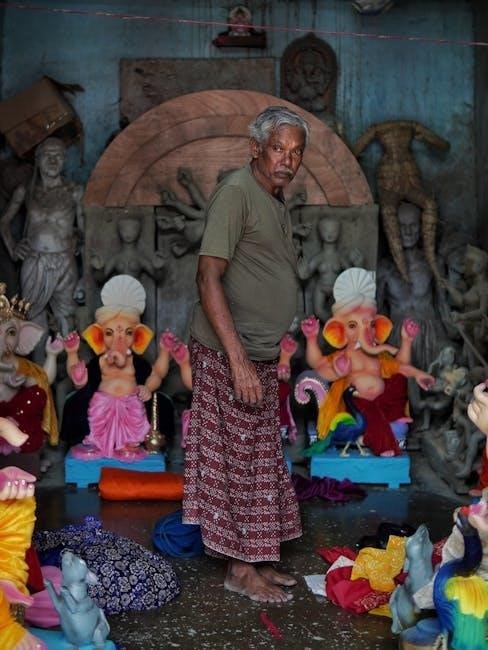
Notable Personalities Associated with Soundarya Lahari
Adi Shankaracharya, the revered philosopher, is traditionally credited with composing Soundarya Lahari. Modern scholars and spiritual leaders continue to interpret and popularize the text, enhancing its accessibility.
11.1 Adi Shankaracharya’s Influence
Adi Shankaracharya, the 8th-century philosopher, is traditionally credited with composing Soundarya Lahari. His profound philosophical insights and poetic brilliance have made the text a cornerstone of Devi worship. The Sanskrit PDF versions of Soundarya Lahari preserve his lyrical and spiritual masterpiece, blending devotion with metaphysical truths. Shankaracharya’s influence ensures the text remains a vital source of spiritual guidance and aesthetic inspiration, accessible to modern seekers through digital formats.
11.2 Contributions of Modern Scholars and Artists
Modern scholars and artists have enriched the understanding of Soundarya Lahari by producing insightful commentaries and creative interpretations. Their work has made the Sanskrit PDF versions more accessible, incorporating explanations and transliterations. Artists, like musicians and dancers, have brought the text to life through performances, blending its spiritual essence with artistic expression. These contributions ensure the timeless appeal of Soundarya Lahari, bridging ancient wisdom with contemporary culture for global audiences.
11.3 Role of Spiritual Leaders in Popularizing the Text
Spiritual leaders have played a pivotal role in popularizing Soundarya Lahari, ensuring its relevance in modern times. Through discourses, commentaries, and public recitations, they have made the text accessible to diverse audiences. Their interpretations often accompany Sanskrit PDF versions, providing deeper insights. Leaders like Swami Chidananda Saraswati and Sri Sri Ravi Shankar have inspired global communities, fostering devotion and cultural pride. Their efforts have revitalized the text’s spiritual significance, making it a cornerstone of contemporary worship and meditation practices;
Soundarya Lahari, in Sanskrit PDF, remains a timeless spiritual treasure, blending philosophy and devotion. Its digital availability ensures accessibility, preserving its cultural and religious significance for future generations globally.
12.1 Summary of Soundarya Lahari’s Significance
Soundarya Lahari, a profound Hindu text, embodies the divine feminine, blending spirituality and aesthetics. Attributed to Adi Shankaracharya, it highlights the non-dualistic philosophy of Shaktism. Its 100 verses praise the cosmic mother, emphasizing devotion, philosophy, and poetic beauty. As a Sanskrit PDF, it remains a vital resource for spiritual seekers and scholars, preserving ancient wisdom. Its cultural and religious significance endures, inspiring art, rituals, and meditation, making it a timeless treasure in Hindu spirituality.
12.2 Future of Soundarya Lahari in the Digital Age
The digital age has opened new avenues for Soundarya Lahari, making it accessible to a global audience. Sanskrit PDF versions are now widely available, ensuring preservation and easy access. Digital platforms are fostering deeper engagement, with searchable texts, downloadable resources, and multimedia presentations. This ensures the timeless wisdom of Soundarya Lahari remains relevant, inspiring future generations through technology and innovation.
